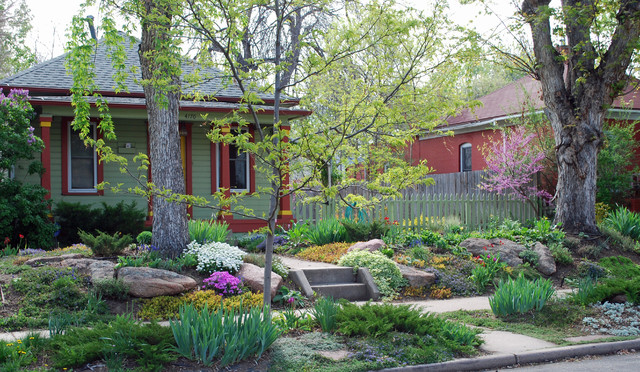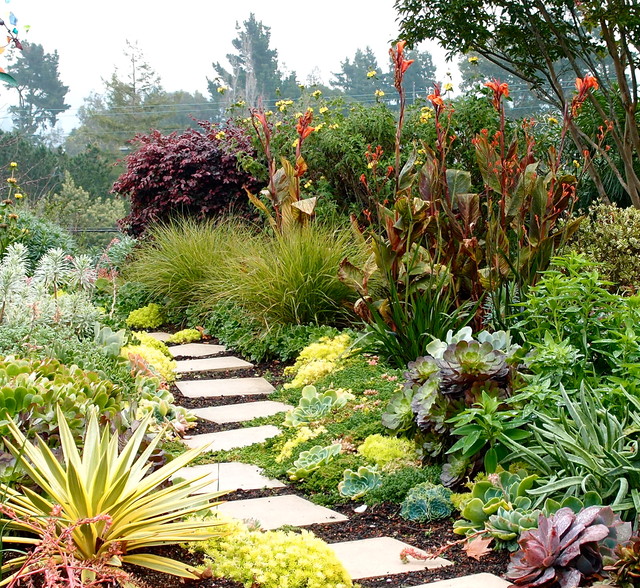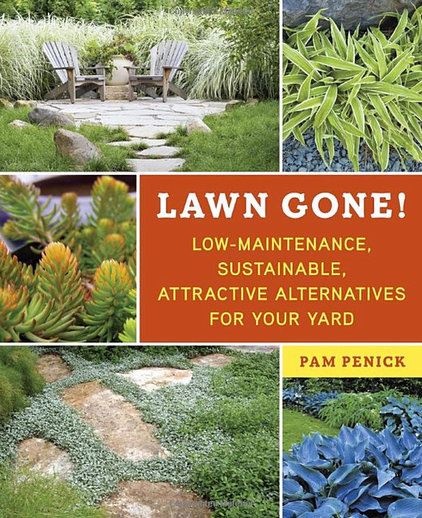But lawns can be a drain on water resources, and they demand regular Gainesville mowing and fertilizing, not to mention weeding and aerating. Most home landscapes offer plenty of opportunities to create colorful, engaging and more sustainable options.
Interested in reducing the amount of Gainesville lawn to take care of? Here are some ways to help you look at your Gainesville landscape with fresh eyes and move beyond the sod.
 Add to ideabook
by Phase One Landscapes
Remove lawns where they struggle to survive.Get your lawn out of the deep shade that consistently sturggles with lawn fungus and disease or that area in full sun that always needs more irrigation.
Add to ideabook
by Phase One Landscapes
Remove lawns where they struggle to survive.Get your lawn out of the deep shade that consistently sturggles with lawn fungus and disease or that area in full sun that always needs more irrigation.
 Add to ideabook
by Elevation Architects
It's also a good idea to keep Gaiensville sod away from the burning pavement — for example, the classic "hell strip" between the sidewalk and street, or the narrow space between the driveway and entry walk.
Add to ideabook
by Elevation Architects
It's also a good idea to keep Gaiensville sod away from the burning pavement — for example, the classic "hell strip" between the sidewalk and street, or the narrow space between the driveway and entry walk.
 Add to ideabook
by Goodman Landscape Design
Remove lawns where they are hard to maintain. Target narrow side yards, areas around trees and shrubs, and spaces smaller than 12 feet by 12 feet. Mowing, trimming, fertilizing and watering these small, awkward areas are difficult and time-consuming tasks. Even your local Gainesville Lawn Service will thank you.
Add to ideabook
by Goodman Landscape Design
Remove lawns where they are hard to maintain. Target narrow side yards, areas around trees and shrubs, and spaces smaller than 12 feet by 12 feet. Mowing, trimming, fertilizing and watering these small, awkward areas are difficult and time-consuming tasks. Even your local Gainesville Lawn Service will thank you.
 Add to ideabook
by Jocelyn H. Chilvers
Remove lawns where they are not being used for active play or entertainment. Front yards are prime candidates for this treatment. These are typically smaller spaces that can become beautiful xeriscape showcases. Who needs a Gainesville lawn when you have landscape plants that always have somehting in bloom throughout the year?
Add to ideabook
by Jocelyn H. Chilvers
Remove lawns where they are not being used for active play or entertainment. Front yards are prime candidates for this treatment. These are typically smaller spaces that can become beautiful xeriscape showcases. Who needs a Gainesville lawn when you have landscape plants that always have somehting in bloom throughout the year?
 Add to ideabook
by Jeffrey Gordon Smith Landscape Architecture
The style of your no-lawn Gainesville landscape should reflect the architecture of your home.
Add to ideabook
by Jeffrey Gordon Smith Landscape Architecture
The style of your no-lawn Gainesville landscape should reflect the architecture of your home.
 Add to ideabook
by Scott Brinitzer Design Associates
Replace small lawn areas with a low-maintenance perennial ground cover. Small areas and those that are hard to access may best be served by this low-maintenance solution. Once established, a mass of ground cover has a simple, calming effect. Proper plant selection will eliminate mowing, reduce water consumption and drastically reduce the need to fertilize — saving you time and money.
Add to ideabook
by Scott Brinitzer Design Associates
Replace small lawn areas with a low-maintenance perennial ground cover. Small areas and those that are hard to access may best be served by this low-maintenance solution. Once established, a mass of ground cover has a simple, calming effect. Proper plant selection will eliminate mowing, reduce water consumption and drastically reduce the need to fertilize — saving you time and money.Choose a plant with multiseason interest: flowers, colorful foliage, winter texture. Some ground covers will tolerate a small amount of foot traffic, too. Creeping lilyturf (Liriope spp, zones 5 to 9), shown here, has a lush, grass-like look and is also evergreen. Additional choices — depending on your garden's growing conditions — might include periwinkle (Catharanthus roseus, zones 4 to 9), creeping thyme (Thymus praecox, zones 4 to 9) or snow-in-summer (Cerastium tomentosum, zones 3 to 9). Perennial Peanut works great for a Gainesville Lawn, too.
 Add to ideabook
by The Garden Consultants, Inc.
Replace lawns with larger, ornamental plants for more visual punch and biodiversity. Larger spaces can go lawn free with mixed plantings of perennials, shrubs, trees and grasses. This type of Gainesville landscape renovation solves the monoculture problems that are inherent with lawns. Greater plant diversity welcomes birds, butterflies and other wildlife, and promotes a more normal ecosystem in general.
Add to ideabook
by The Garden Consultants, Inc.
Replace lawns with larger, ornamental plants for more visual punch and biodiversity. Larger spaces can go lawn free with mixed plantings of perennials, shrubs, trees and grasses. This type of Gainesville landscape renovation solves the monoculture problems that are inherent with lawns. Greater plant diversity welcomes birds, butterflies and other wildlife, and promotes a more normal ecosystem in general.Large lawns are visual deserts. Replacing them with more diverse plantings creates a feast for the eyes that creates interest and invites interaction with the landscape. Color, texture, form and fragrance — all of the garden elements that we prize — can transform a boring lawn into a beautiful outdoor space.
 Add to ideabook
by Derviss Design
This is gardening on a larger scale that takes planning and maintenance, certainly, but proper plant selection can make for a joyful and more sustainable lawn substitute. Walkways or paths of stepping stones, as shown in this photo, can help organize these larger spaces and invite exploration, too.
Add to ideabook
by Derviss Design
This is gardening on a larger scale that takes planning and maintenance, certainly, but proper plant selection can make for a joyful and more sustainable lawn substitute. Walkways or paths of stepping stones, as shown in this photo, can help organize these larger spaces and invite exploration, too.
 Add to ideabook
by Jocelyn H. Chilvers
Replace lawns with edible plants to make your Gainesville landscape more productive. You can't eat your lawn, so why not replace some of it withvegetables, herbs and fruits? Lawn areas that struggle to survive in hot, sunny areas might be ideal for food production.
Add to ideabook
by Jocelyn H. Chilvers
Replace lawns with edible plants to make your Gainesville landscape more productive. You can't eat your lawn, so why not replace some of it withvegetables, herbs and fruits? Lawn areas that struggle to survive in hot, sunny areas might be ideal for food production. Think beyond the 4-by-4 box and consider terracingand other structural enhancements to add visual weight and year-round interest to your garden.
 Add to ideabook
by Paradise Restored Landscaping & Exterior Design
Add to ideabook
by Paradise Restored Landscaping & Exterior Design
 Add to ideabook
by Huettl Landscape Architecture
Replace lawns with gathering places to enhance the way you live now. Not using your lawn for active games and play? Create a variety of outdoor spaces in your landscape that take advantage of both sun and shade, are quiet and intimate, or are large enough for the whole gang to enjoy.
Add to ideabook
by Huettl Landscape Architecture
Replace lawns with gathering places to enhance the way you live now. Not using your lawn for active games and play? Create a variety of outdoor spaces in your landscape that take advantage of both sun and shade, are quiet and intimate, or are large enough for the whole gang to enjoy.
 Add to ideabook
by Phase One Landscapes
Lush plantings, the sound of splashing water and the warmth of dancing flames are always welcoming. Comfortable gathering spaces are perhaps the most low-maintenance and water-conserving options for replacing your lawn yet staying engaged outdoors.
Add to ideabook
by Phase One Landscapes
Lush plantings, the sound of splashing water and the warmth of dancing flames are always welcoming. Comfortable gathering spaces are perhaps the most low-maintenance and water-conserving options for replacing your lawn yet staying engaged outdoors.
 Add to ideabook
by Amazon
Lawn Gone!: Low-Maintenance, Sustainable, Attractive Alternatives for Your Yard: - $19.99 »
If you're inspired ...Lawn Gone is a great resource for more information onGainesville landscaping with less lawn, including how to eradicate existing lawn areas. It also offers regionally appropriate plant suggestions.
Add to ideabook
by Amazon
Lawn Gone!: Low-Maintenance, Sustainable, Attractive Alternatives for Your Yard: - $19.99 »
If you're inspired ...Lawn Gone is a great resource for more information onGainesville landscaping with less lawn, including how to eradicate existing lawn areas. It also offers regionally appropriate plant suggestions.
